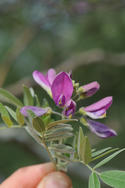
The cork bush is a very attractive plant. It has pale grey leaves embedded with fine silver hairs that make the whole plant seem shiny. When in flower, the cork bush turns vibrant purple with dense bunches of blossoms.
The bark of the cork bush is thick, furrowed and corky which is where its common name comes from. It contains rotenone which acts as an insecticide. Like the leaves, the flat brown pods are velvety in texture. The Latin species name, 'sericea', means ‘silky’ due to the nature of the leaves and pods.
Cork Bush Uses
The bark (and seed) is also used extensively as a fish poison actually killing fish when it is crushed and introduced to isolated pools of water. It does not merely stun the fish as many other fish poisons might.
The Zulu people use the bark of the cork bush to treat people which have been poisoned as it has an emetic effect (i.e. causes vomiting).
The roots of the cork bush are used in traditional rituals. These are powdered and given to couples that are experiencing repeated miscarriages. While the ritual is in progress, the husband and wife team are actually tied back-to-back to the cork bush.
The cork bush is visited by nectivores like sunbirds when it is in flower.
Cork Bush Fast Facts
Height - 2-3 m (up to 5 m)
Growth form - Shrub or small tree
Leaf type - Imparipinnately compound
Leaf arrangement - Alternate
Leaf margin - Entire
Habitat - Open woodland and rocky or sandy areas
Deciduous or not - Evergreen
Most notable fruit/flowering season - Flowers Oct to Feb
By Megan Emmet